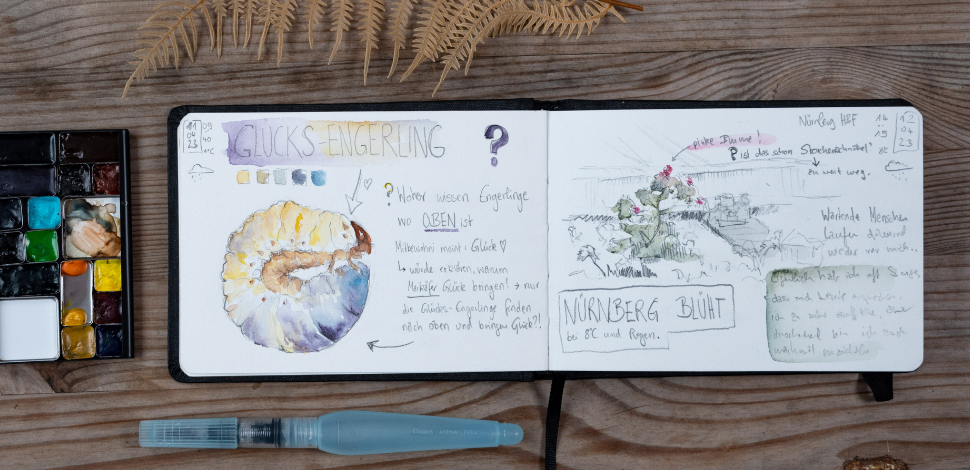We are delighted to be here with you and are looking forward to getting to know you a little better.
Perhaps you could briefly introduce yourself to our readers. Who are you? Where are you from? What do you do?
Thank you so much, this is a personal “fan girl moment” for me to be invited to a conversation by my favourite paper!
I’m Verena Hillgärtner, 35 years old and originally from the Munich area. At the moment, I am living in my adopted home city of Berlin and have been for over 7 years. I wilfully traded the view of the Alps and deep spruce forests for the hustle and bustle of the big city, I was rewarded with more wilderness than ever before. After my studies in art education and media informatics, I trained as a state-certified educator and then as a wilderness educator.
A few years ago, these ingredients gave rise to the idea of combining my three passions in a self-employed business: Art, nature and people.
Since then, I have been on the road as a “Nature Journaling Teacher” with my company “Wieder Wilder Werden” (Becoming Wild Again), giving workshops and accompanying people (especially via social media) on their creative nature connection journey.
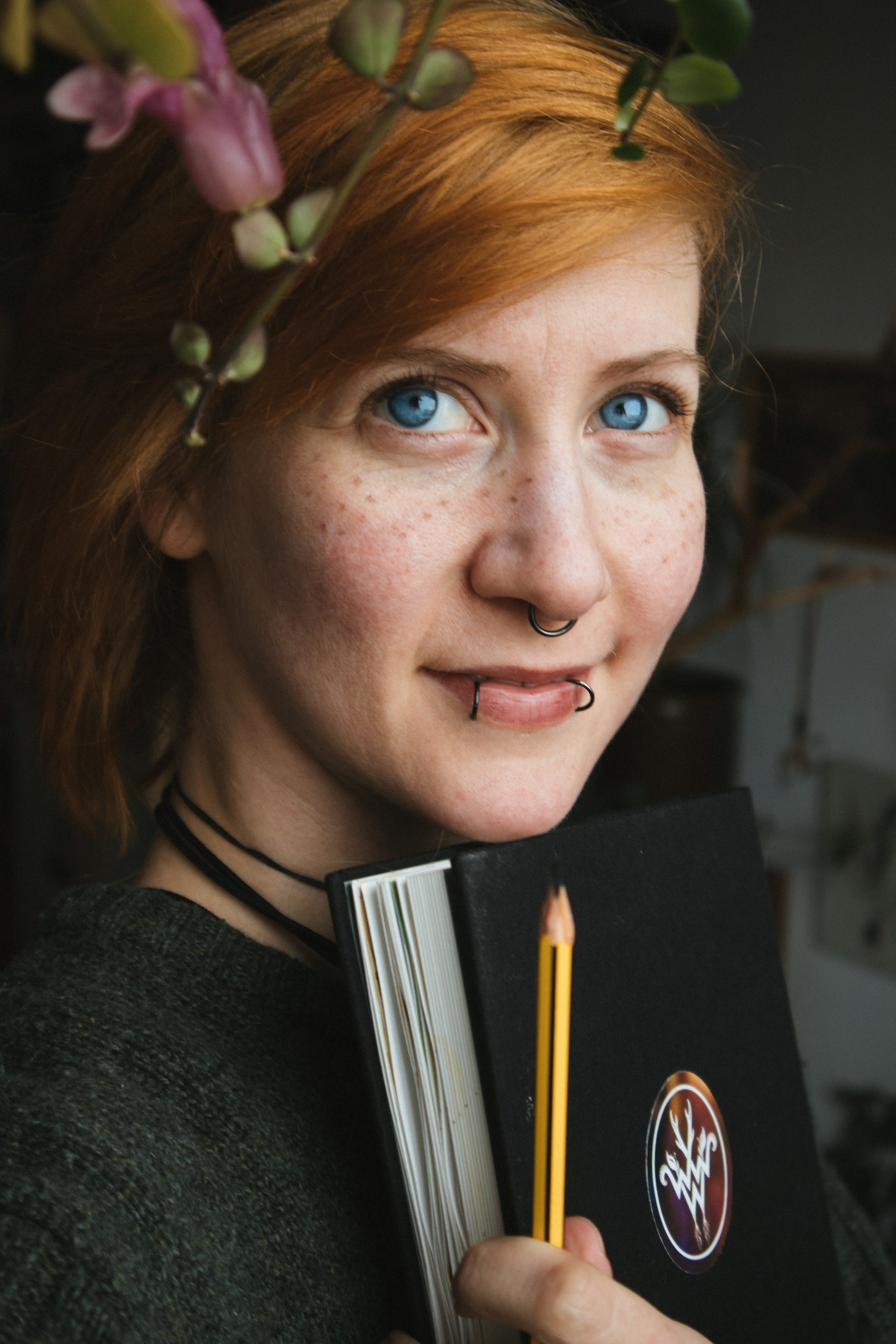
Your website and your social media channels are called “wiederwilderwerden”. Sounds exciting and like rebellion. Is this a call to yourself to dare a little more, to move out of your comfort zone? Why the name?
The name “Wieder Wilder Werden” (“Become Wilder Again”) was a challenge and reminder to myself at the beginning of my journey. Freshly arrived in Berlin, I set myself the task of becoming a little “wilder” in the urban wilderness with each passing day. I want to live close to nature and find my way back to an original and wilder way of life. The translation of the English word “rewilding” into the German word “Wilder Werden” was quickly found. Finding our way back home, back to our roots. Actually, less a rebellion than a return to our origins, which is more than good for us in times of climate crisis and ecological catastrophes.
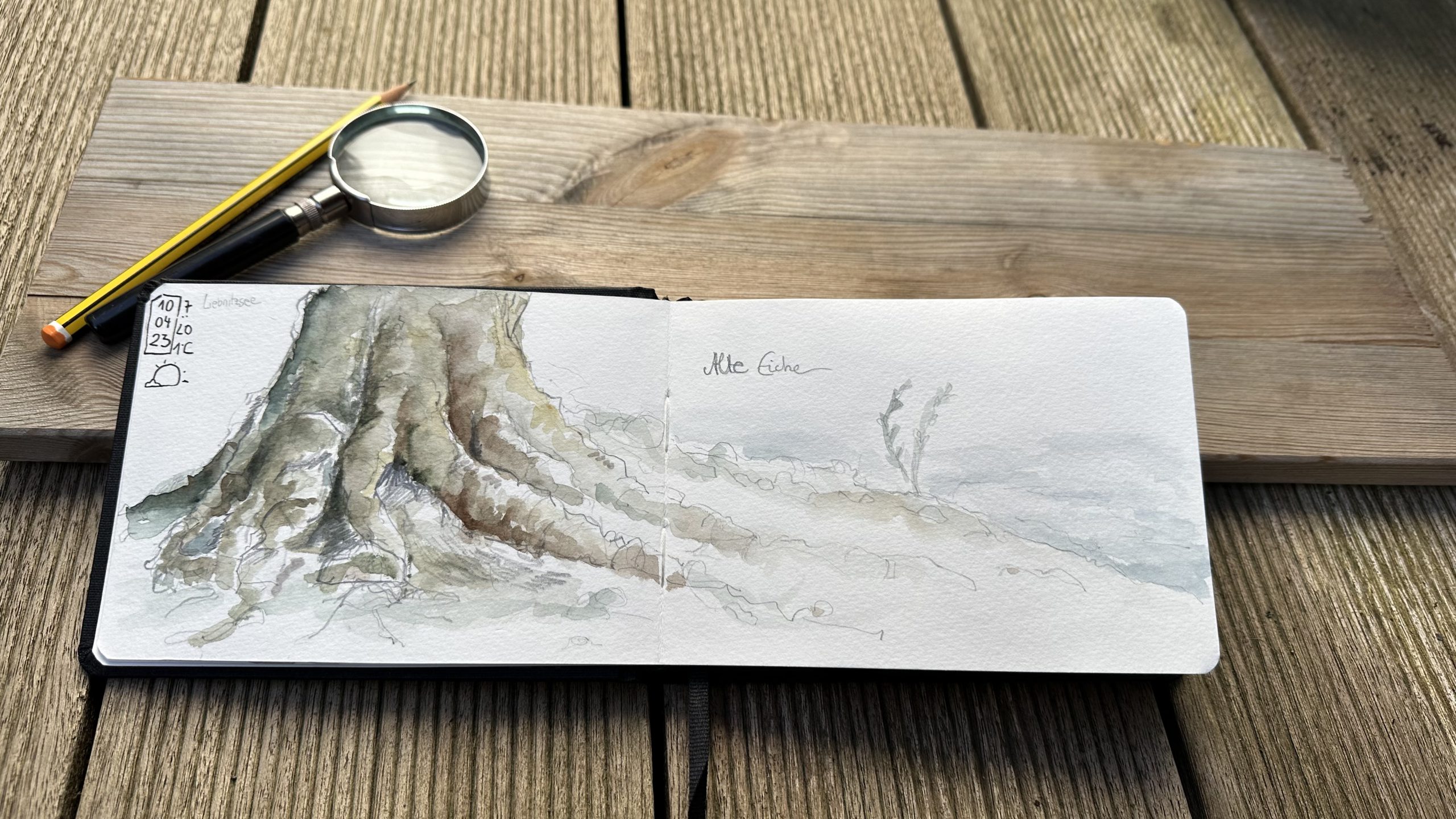
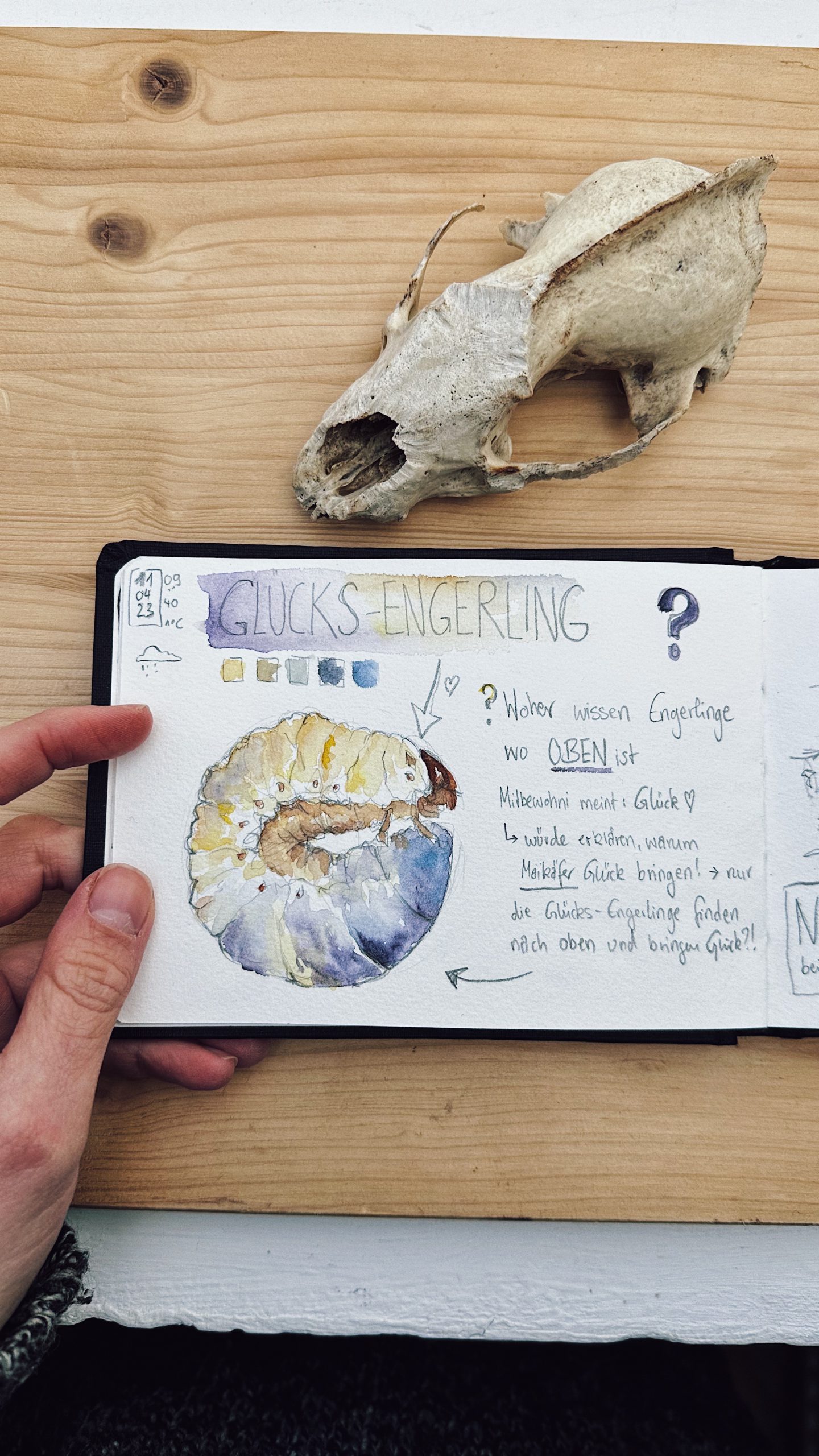
We became aware of you and your Nature Journaling on the internet. Could you explain to us and the readers what Nature Journaling is exactly and what is important in this technique?
I like to describe “Nature Journaling” as a kind of a wonderful dance between creative, poetic and also scientific methods, through which I can connect with my surroundings, become curious again and learn to see nature with completely new eyes. By consciously perceiving, being in the here and now, asking questions and light-heartedly creating small sketches, I appreciate the small, magical moments of everyday life that otherwise often quickly get lost. Pen and paper act as a minimalist and effective tool for (re)building the wonderful relationship between me and my environment.
Art and nature are a great combination. How did you come to choose nature journaling? What fascinates you about it?
For me, both aspects, art and nature, have always been part of my life. It’s strange that it took me so long to put 1 + 1 together and create a new whole out of the two subjects close to my heart. I first encountered the idea of Nature Journaling in 2018 via “John Muir Laws”. He puts out an incredible amount of info about Nature Journaling, much of it also free on YouTube. His concept finally took away the last fears that had been haunting me since the beginning of my artistic career. It’s NOT about painting pretty pictures, it’s about learning to see in a new way, the discovery, the joy, the curiosity, the community.
I suddenly gave myself permission to not worry about the fact I don’t have to know everything about nature or art to start “sketching nature”. I am allowed to be myself, allowed and SHOULD even ask questions to which there are no answers. There is no rulebook, no doing the wrong thing. There is only the doing, and thus leaving behind a declaration of love for this wonderful world with every stroke of the brush. And in the end, also preserving it. That fascinates me to this day and I want to pass it on to as many people as possible.
We are curious; you are a wilderness educator. What exactly is that?
I would describe wilderness education, as I got to know it, as a personal journey to a closer life with nature. Besides skills like building a shelter in the forest, starting a fire with just a fire drill, carving, etc., you also learn to listen to bird language, how to live well outside and in community, you read the tracks and footprints of animals and create a “nature journal.” It’s about not seeing nature as an enemy. We are more like little children who, bit by bit, are allowed to learn how we can feel comfortable outside and live with what nature provides us and become at home. I like to pass on this feeling of well-being outdoors to other people in the form of nature journaling.
What is particularly important to you when documenting a Nature Journal? Do you have special rituals, or do you just go for it?
Yes, it is almost festive to unpack my journal! The most important thing is to have it with you or close by right from the start. The best sketchbook or pen is no use if it’s lying at your desk at home. Therefore: ALWAYS have it packed.
When I open the journal, the very first thing is to put some “metadata” on the page: Date, place, time, temperature, weather… everyone has different preferences. They are important to me because otherwise I quickly forget the context in which the page was created. And often there is great astonishment afterwards: “Wow, two years ago there was still snow at the end of April!” or “Oh, last year the hazel blossomed three weeks later!”
Then I see where my curiosity takes me. I like to change into a listening role here; become quiet and observe. Is a bumblebee buzzing next to me, is an unknown herb growing next to me? What birds can I hear? What does the light look like that falls through the trees behind, how do the dewdrops hang on the blades of grass? It is often difficult to decide on one thing. That’s why I always give our community a weekly theme in the Lives on YouTube, for example the wood anemone. Then we have a focus. And then, of course, anemones suddenly appear everywhere that we had previously overlooked and faded out due to a lack of a concept.
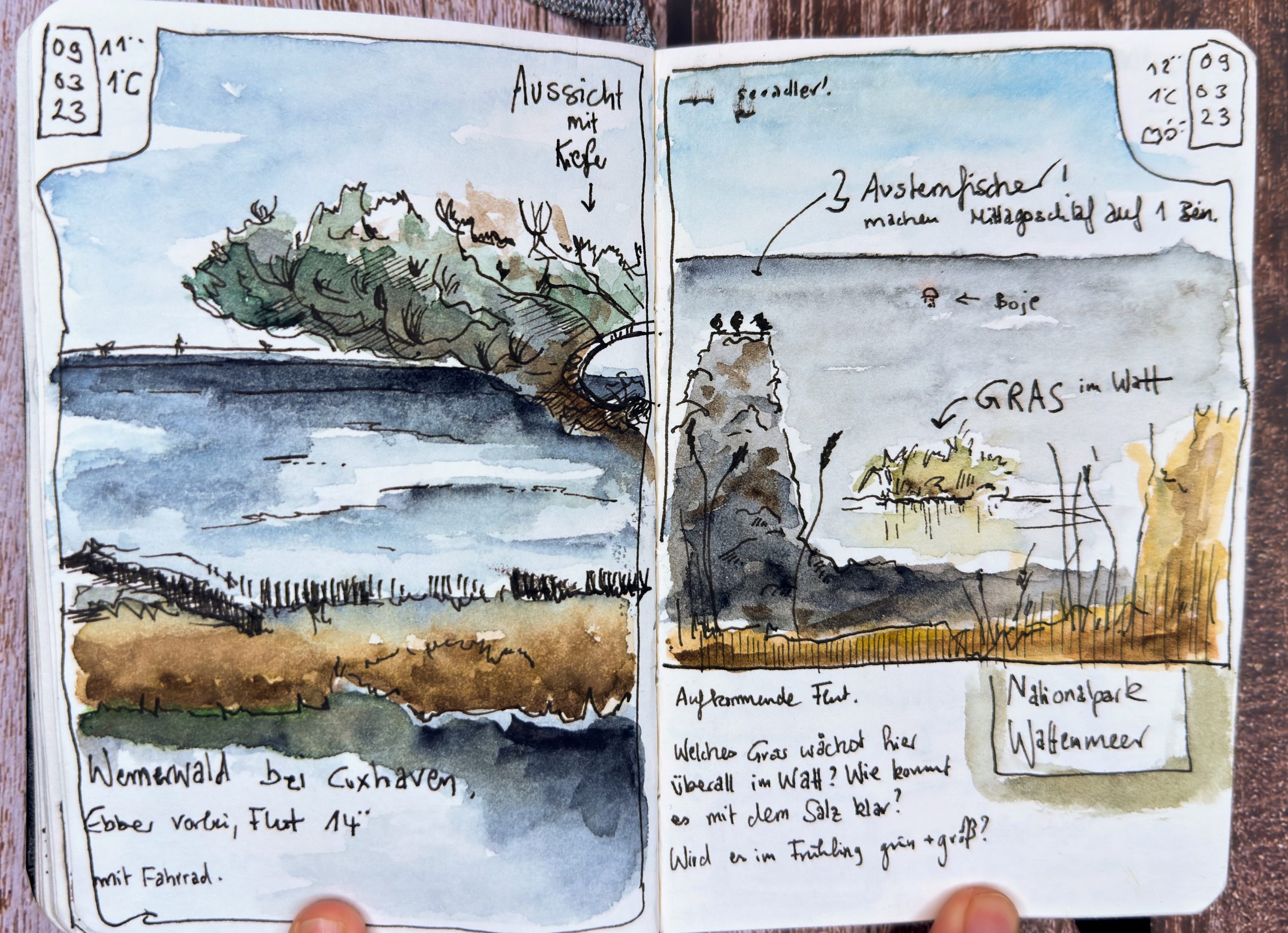
What does Nature Journaling mean to you?
It is my personal journey back to nature and myself, my calling, my life. I would say that I am addicted to it. My first grab this morning was a pen and journal, as a wood pigeon landed on the window sill. I was desperate to immediately capture the fascinating shape of her pupils.
Nature journaling is like magic! The whole world is wrapped in a spell and you can discover it piece by piece with your pen and weave it along. Everything around you suddenly becomes infinitely precious, you can go down a rabbit hole of questions and discover wonders through every seemingly mundane stone. It is my way of saying thank you to this world, of expressing this appreciation and passing it on.
Nature journaling is also about taking a close look, taking time to perceive the environment. This is a contrast to today’s increasingly fast-paced world. Does it also help you to slow down or calm down?
Absolutely! I can’t “quickly” take a snapshot of a bird in passing. I have to take my time and get to know it. There’s no fast-forwarding, no double speed and no shortcuts. I help myself get back to real time. And sometimes time also stops completely, in amazement; or flies by in an instant! While I become very still and gaze at a bird, trying to journal it, I can’t give much thought to my emails or other tasks at the same time. That would be polite neither to the bird nor to me. I am completely present.
Do you only journal in Berlin and the surrounding area or do you also take your journal to other places, e.g. on trips, and record your impressions there?
The best journal is the one you always have with you! Especially when I’m travelling, my “nature sketchbook” or “wilderness diary” (as it can also be called) helps me to remember. It’s like an old photo film where there were only 24 pictures. I have to decide which of the many wonderful encounters, experiences and questions I want to capture in my journal. Snapshooting every situation, like with the smartphone camera, is not possible here. I really must sit down full of appreciation, calmness and curiosity with the interesting flower by the wayside, sit down in the grass for at least 10 minutes, take in its perspective. Briefly become its neighbour and get to know it. The pen must be consciously guided by me on the paper. I have to look carefully and take my time.
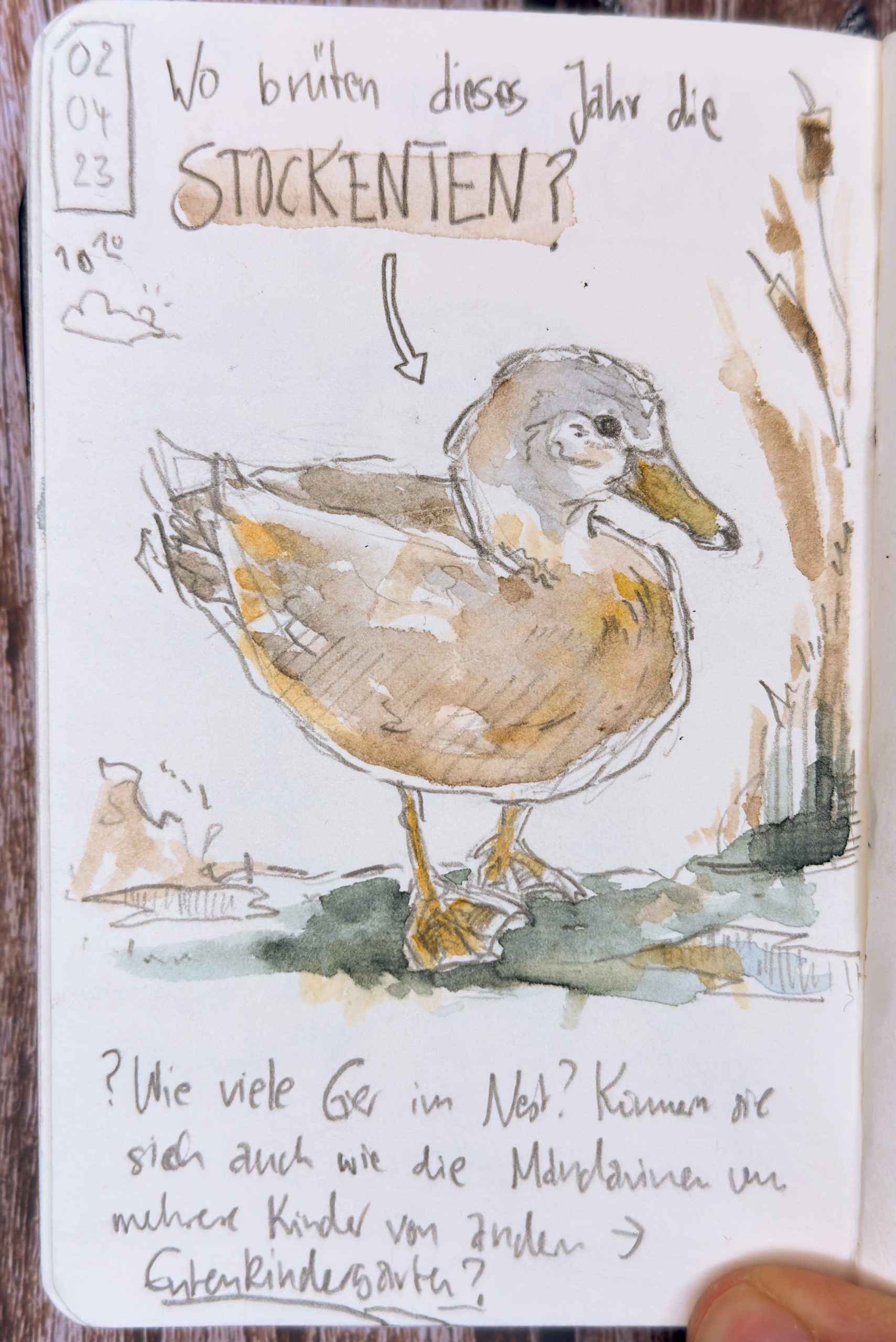
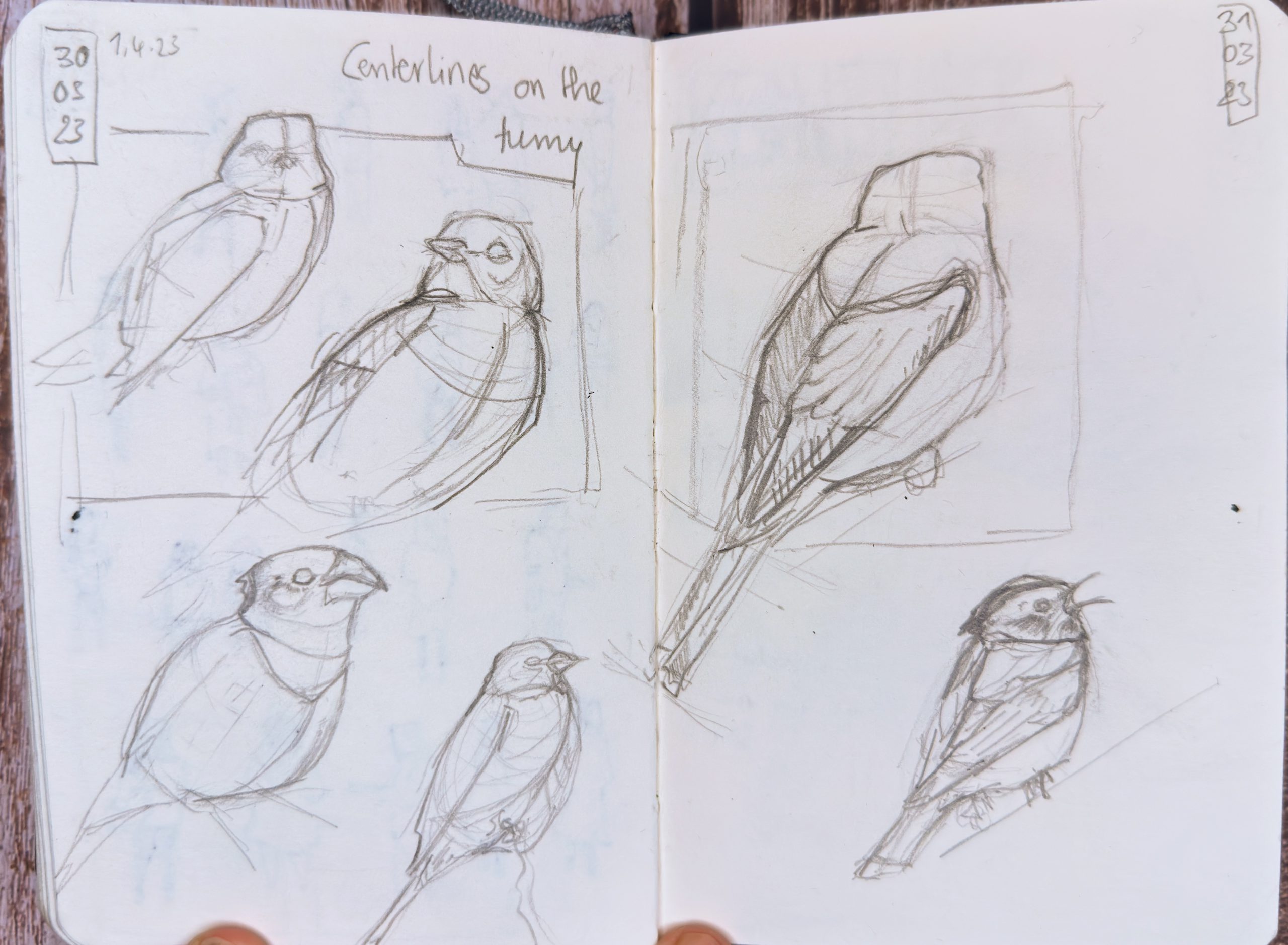
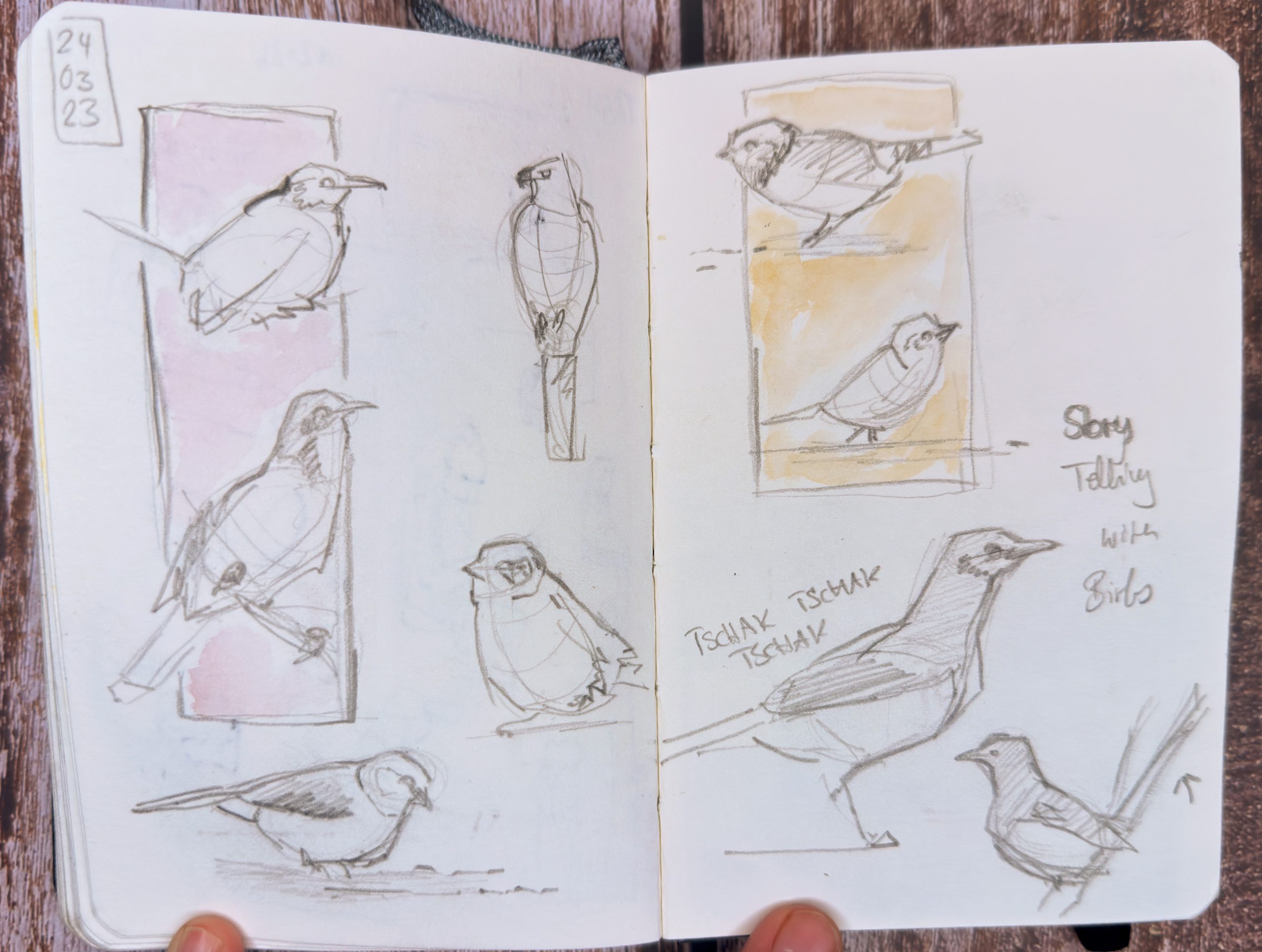
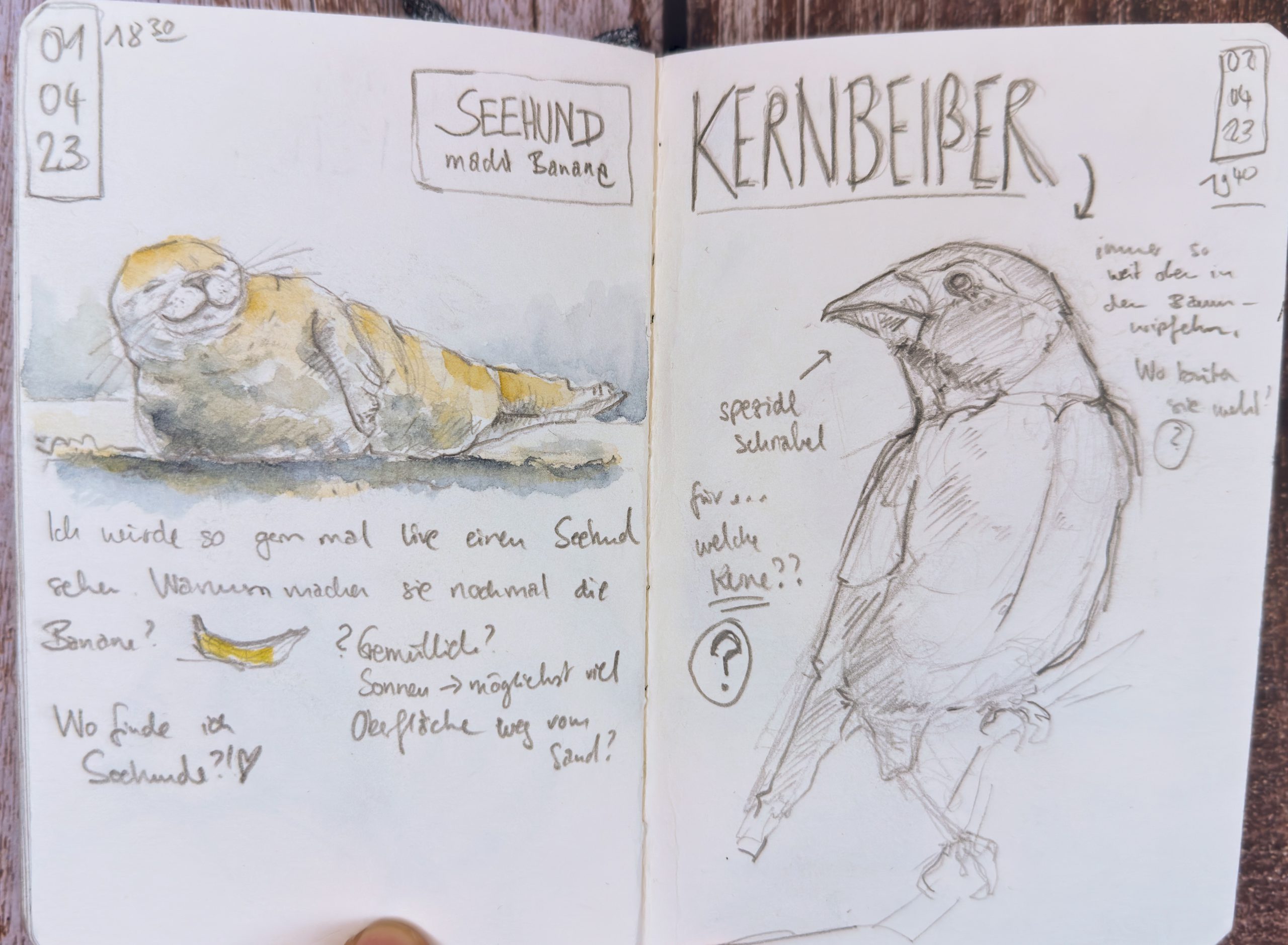
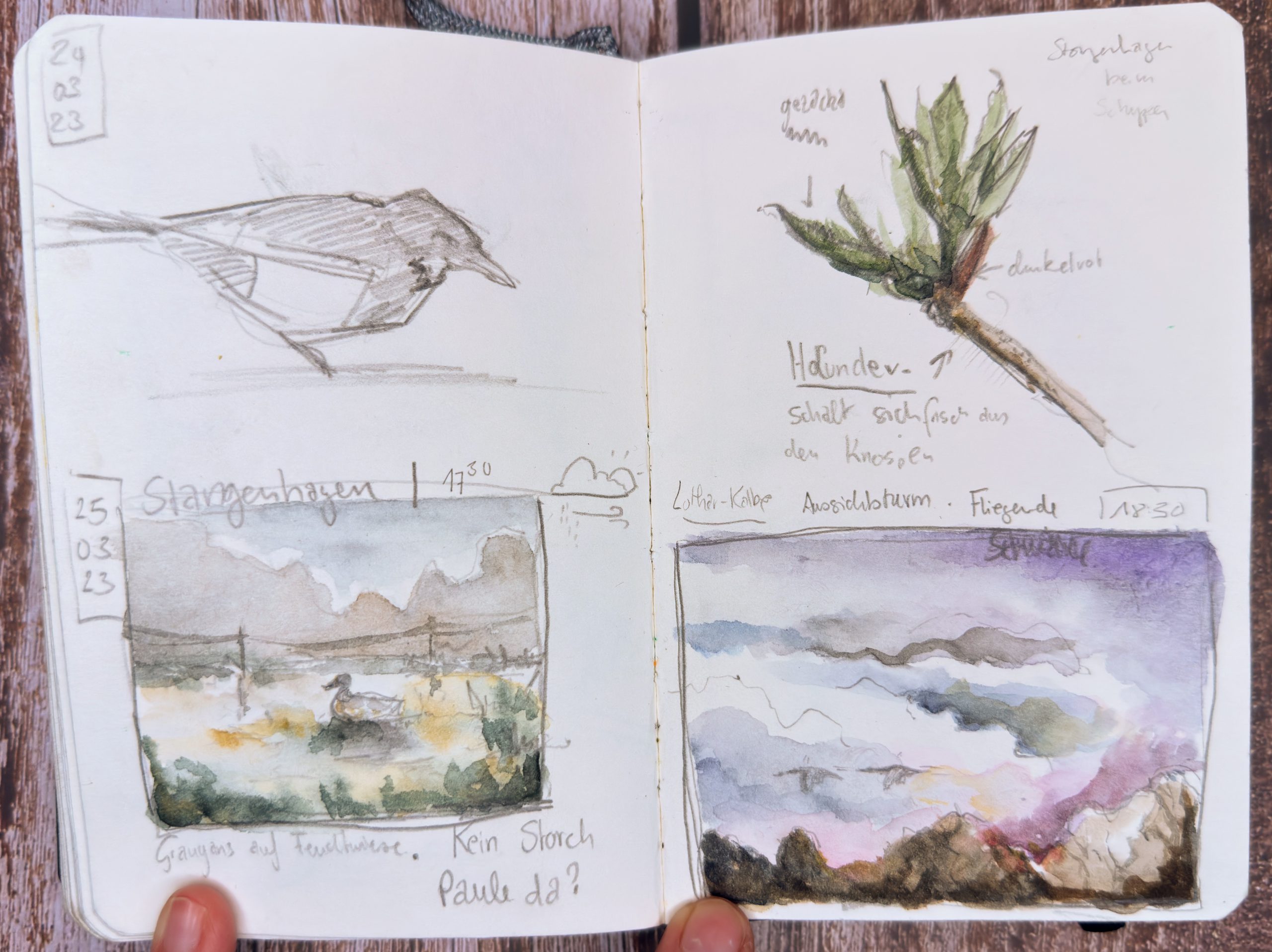
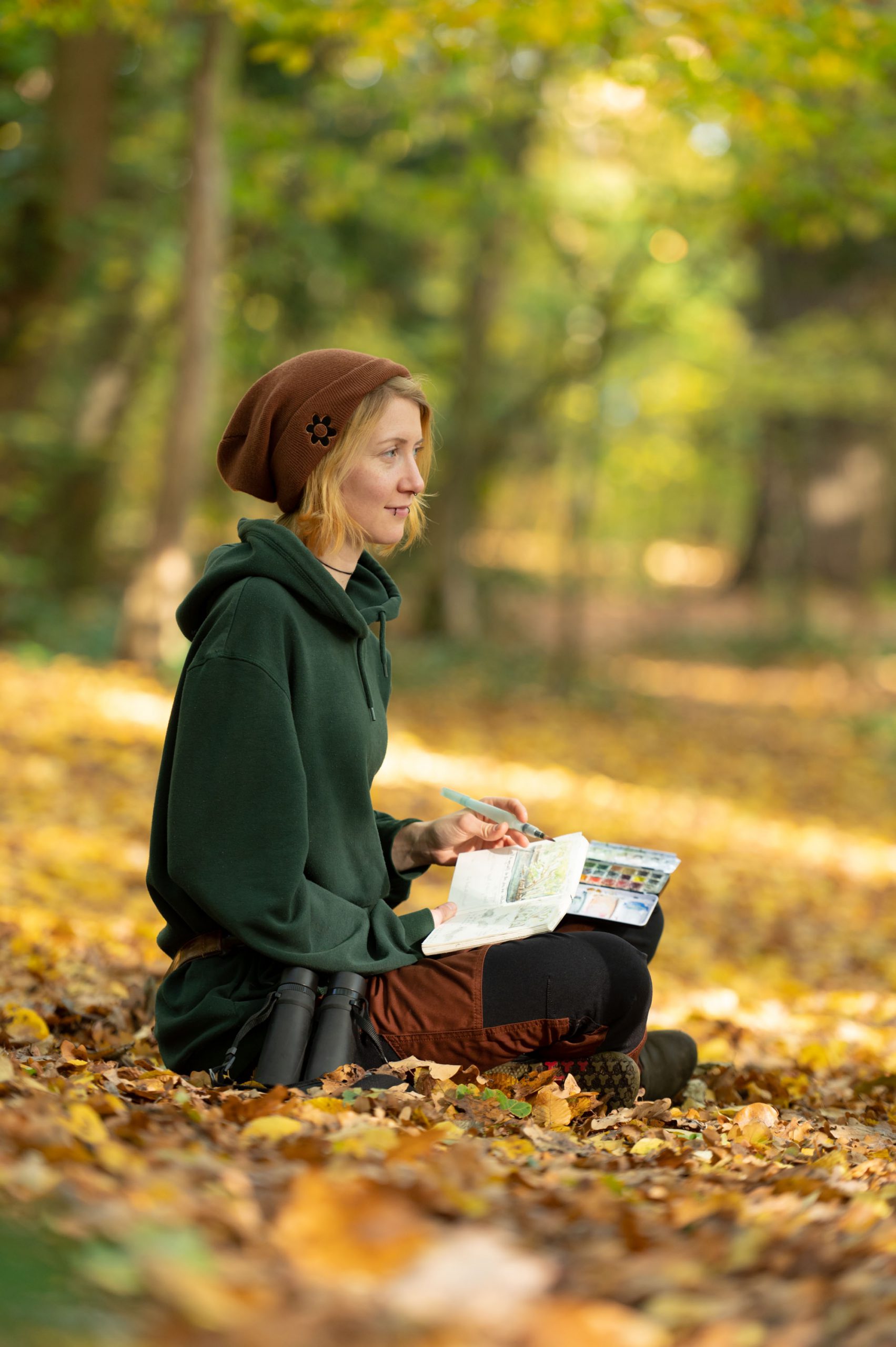
Is there a place you would like to make a Nature Journal of? If so, which place do you have in mind?
I would love to experience and capture more extreme weather conditions when journaling. Although I like to observe and journal bugs in the meadow at 20°C and sunshine, I would find it super exciting to journal in extreme cold near the Arctic Circle, for example. Depicting snow on white paper, the challenge of getting the moment down on paper quickly in double-digit sub-zero temperatures with calm and focus, and getting to know my own comfort limits over and over again. I’ve seen colleagues fill their water tank brushes with gin instead of water when it’s extremely cold, so they can still paint with watercolours! I would love to try that out for myself!J
But otherwise, I am happy with every bit of forest and meadow and can spend endless hours there with my journal being enchanted by nature.
You run online and offline workshops to teach people about this technology. What do you find so exciting about it?
On the one hand, I find it a very connecting, exciting and relaxing activity to engage with nature in so many different ways. I find it very fulfilling to see people blossom. To see the sparkle in their eyes when they realise that they have been busy with a small piece of branch or an old leaf for over an hour. Passing on this mindfulness and love of nature in this way makes me very happy.
In addition, it is my way to save this world. We are deep in a climate catastrophe. The more people pay attention to this wonderful world and give it love, the better. To every little bug, snail, bird or wild herb that we meet with respect and love, we build deep connections, weave a web of relationships. Everything is connected to everything. We get to know our environment, and we can only protect what we know.
Working with children seems to be very important to you and a lot of fun, also in view of your professional orientation. Are your courses also suitable for younger participants?
Nature Journaling is for people of all ages. With very young people who can’t write letters yet, I work more with the senses (yup, the blueberries and dandelion flowers sometimes end up crushed on the paper – also a way of getting to know each other and building relationships!). It is also wonderful to make contact with nature with people of advanced age. To go out into nature with them again, often after a long time of just being indoors, and to listen to their earlier experiences and encounters with nature and to immortalise their stories in journals that might otherwise never have been told again. There is often a tear or two shed.
Nature journaling also connects young and old across generations. Some help with things that others can no longer or not yet do, and vice versa. And what they all have in common is that they sink more and more into deep fascination and love for nature and appreciate this time together with great gratitude.
You also use Hahnemühle papers and books. Which Hahnemühle papers do you prefer and why?
Yes, I have been a big Hahnemühle fan since my university days! I’ve always tried out other papers and then ended up back with my “Hahnemühle” favourites. Especially for nature journaling, I like to use the Travel Journal (in Din A5 and Din A6) for quick sketches and casual experimentation. In my experience, the paper even copes very well with a soft layer of watercolour!
But if I want to delve a little deeper into the colours of nature and want a bit more “waterproof” paper, I like the Watercolour Book made of 100% cotton! Both the A5 and the handy A6 versions are my absolute favourites. The watercolours are made for the paper and look even better when dried!
If any of our readers would like to start Nature Journaling, what would you advise them to do in the beginning?
Especially in the beginning, it’s not about having a backpack filled to the brim with brushes, colours and pens, but about DOING. You have to get into action, preferably practising every day. Because you can only learn to observe and also to draw through regular practice. I like to compare it to going jogging or learning an instrument, because there it is often more obvious to us: we wouldn’t ask ourselves to run a marathon tomorrow or play in an orchestra without practising. That takes a lot of dedication and time. It’s the same with drawing: Practice it every day, run your “pencil kilometres”, even if it’s just a few strokes. But keep at it.
Get into action with everything: If you only invest in one thing to begin with: treat yourself to good paper, it makes such a big difference. You don’t need a shopping cart full of art supplies to start your Nature Journaling journey. All you need is ONE good sketchbook (e.g. the Watercolor Book 100% Cotton), a pencil, fine liner and watercolour paints (3 primary colours are enough). Less is more, get some good quality art supplies right from the start.
And then: Just get out and do it.
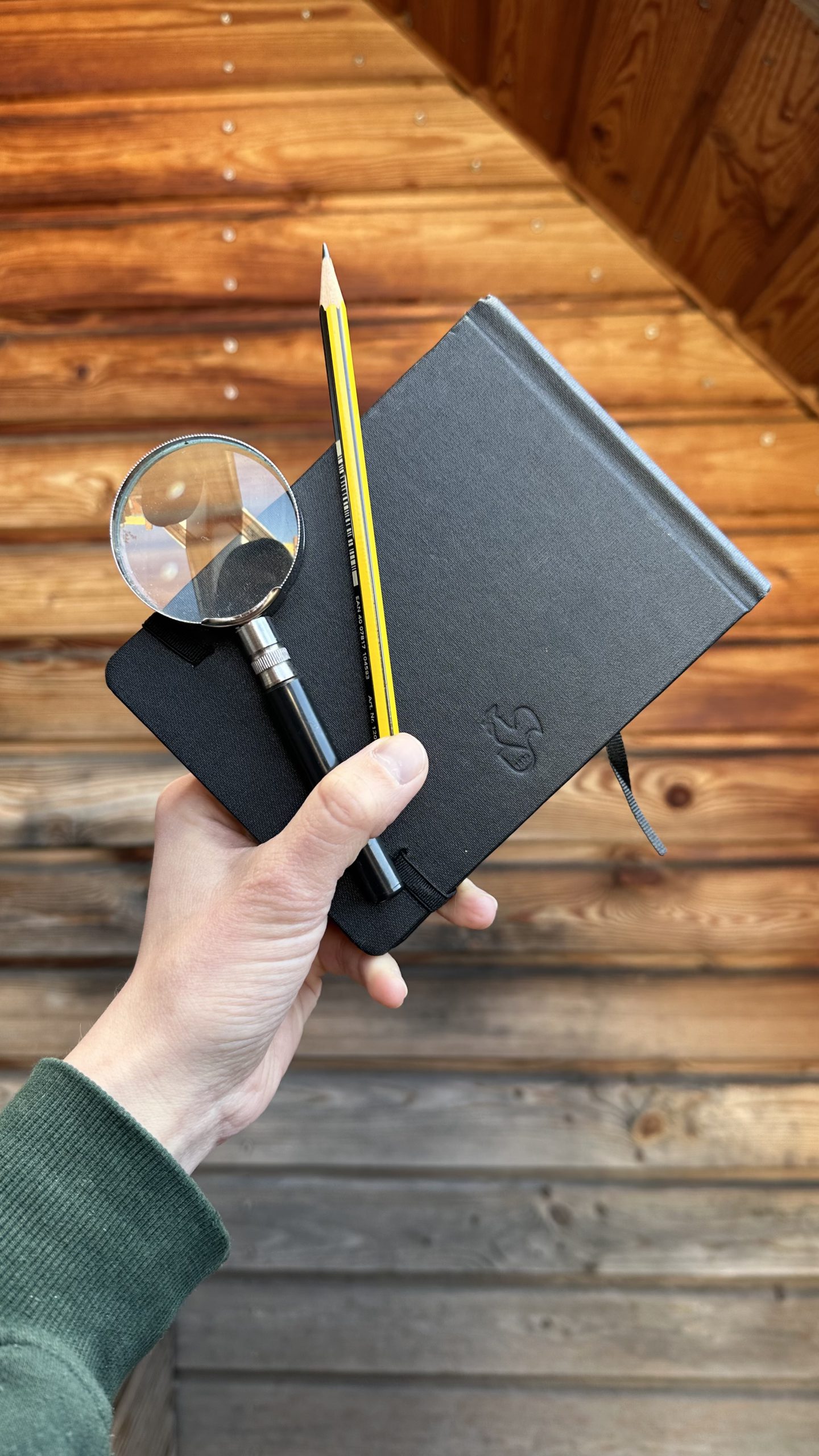
We thank you for your time and the interview and wish you all the best for your future!
Feel free to check out Verena Hillgärtner’s Instagram channel and website “Wieder Wilder Werden” for inspiration!


